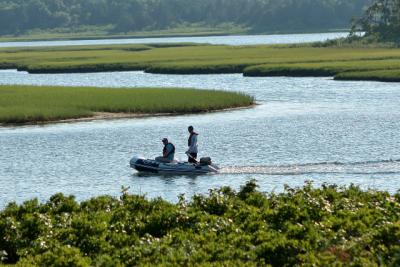Waterways Report Is Mixed

Quality in many East Hampton Town waterways is excellent, according to recent testing, but problems in Three Mile Harbor and Georgica Pond require particular attention.
This was the news at a meeting of the East Hampton Town Trustees on Tuesday when Dr. Christopher Gobler of Stony Brook University summarized the findings of a study undertaken last year of the waters under their jurisdiction. He will present a full report on Wednesday at 6 p.m. at Town Hall.
Dr. Gobler’s research team monitored more than 15 marine and freshwater sites between the spring and fall. “The oxygen levels throughout most of the waters — almost all of them — was quite high, perfect for sustaining robust aquatic life,” Dr. Gobler said on Tuesday. “The chlorophyll levels were perfect, in that high levels would be indicative of algal blooms, and low levels might suggest there’s not enough food for shellfish. The levels were quite adequate.”
However, Dr. Gobler called the measurements of toxic algae that can be harmful to marine life in Three Mile Harbor troubling. “We saw, for example, what’s known as paralytic shellfish poisoning,” he said. Last spring, “that reached its highest levels, of all the waters, in Three Mile Harbor.”
Also in Three Mile Harbor, levels of cochlodinium, or rust tide, were highest in the fall. “Clearly, something is going on there, and we think that’s worth following up on in 2014 to get a better handle on not just the dynamics of the algae but also linkages to nutrients,” Dr. Gobler said.
Sampling in Georgica Pond did not reveal high levels of cyanobacteria, or blue-green algae, as might have been expected, Dr. Gobler said, “but there were some other indications of compromised water quality: total algal levels getting high in the late summer and surprisingly low levels of oxygen,” which could inhibit aquatic life.
In 2012, after a dog that may have ingested water from or near the pond died, it was feared that the pond did contain cyanobacteria, which can cause adverse health effects. Follow-up was important, Dr. Gobler said.
Citing year-to-year variability, Dr. Gobler said it was important to continue sampling water quality, and he proposed that the work continue this year. He also recommended installing monitoring devices in Georgia Pond that would continuously measure oxygen levels so that the trustees could be notified instantly of adverse conditions.
“Certainly, we would talk with the D.E.C. as well,” he said. “This is designed to do rapid sampling and rapid response . . . so you can be acutely aware of anything that can change.”
When Dr. Gobler’s study was initiated, the trustees had asked him to pay particular attention to coliform bacteria. In November, the state’s Department of Environmental Conservation had prohibited harvesting of shellfish on a year-round or seasonal basis in areas of Hand’s Creek, which is an arm of Three Mile Harbor, and Accabonac Harbor, citing increased levels of fecal coliform bacteria and the potential for shellfish from the affected areas to cause illness if consumed.
“We got some interesting information,” Dr. Gobler told the trustees. “There were some areas that were closed that our data suggests actually could have been open. Conversely, there were a couple of areas where they . . . were open, and the data we used said maybe they should have been closed this time of year.”
Stephanie Forsberg, a trustee with a doctorate in marine biology from Stony Brook who had worked in Dr. Gobler’s laboratory as a student, said the sampling program was “very rare to have on the East End of Long Island. There is no other lab in the vicinity that is looking at these things, or has the expertise to do so.”
Ms. Forsberg said the data Dr. Gobler gathered would provide a useful baseline for the future. “I think it’s a huge step for the town,” she said, thanking Dr. Gobler and his lab. “It’s important to us, and we know it’s important to our residents, because they keep telling us that,” she said.
Ms. Forsberg moved to reserve money to cover the cost of water-quality testing this year, which she put at $38,178. The board voted unanimously to do so.
